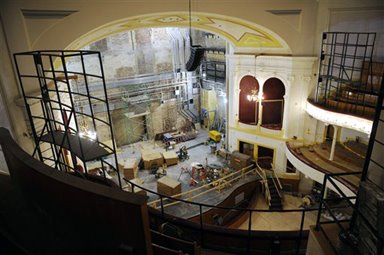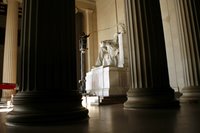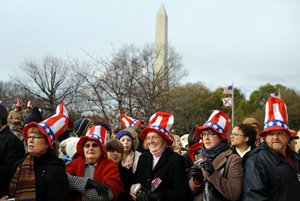Inauguration Guide: What to See in D.C.

By Brett Zongker
Associated Press Writer
WASHINGTON — Presidents are "in" again, and that means Washington is a hot spot.
With Barack Obama moving into the White House and the ongoing celebration of Abraham Lincoln's life, the nation's capital and its many tourism sites have been thrust into the spotlight.
As the nation installs its first black president, dozens of exhibits and attractions in early 2009 are touching on the inauguration, the nation's political and social history and its progress from the struggle for civil rights.

Obama will be inaugurated as the 44th president one day after the Martin Luther King Jr. holiday and a few weeks before the 200-year anniversary of Honest Abe's birth on Feb. 12, 1809. The symbolism and power of history could draw millions of people to the inaugural and in the weeks that follow. For the city's museums and memorials, this is a key moment.
Some unique sites are in the middle of Washington yet off the beaten path for most tourists. One example, the Decatur House museum, was the first neighbor of the White House built on Lafayette Square in 1818. The house, once an unofficial residence for secretaries of state, includes slave quarters within steps of the White House — though they usually go unnoticed amid the hustle of the city.
"It's a sensitive subject. It's an important subject, though," museum director Cindi Malinick said of an exhibit on black history in the White House neighborhood. "The more we discuss it and discuss ... how these people lived and worked and got through their lives, I think the better off we all will be as a society."
Decatur House, now administered by the National Trust for Historic Preservation, holds one of the few remaining examples of what urban slavery was like in 19th century America, Malinick said.
It was there that 15 members of the King and Williams families lived together in three rooms on the second floor of a building located behind the red-brick house. They were considered the property of John Gadsby, owner of the National Hotel in the 1800s. Gadsby was said to have made a fortune in the slave trade.
A 2002 renovation uncovered the original floor, walls and fireplaces of the slave quarters, which are on view in the exhibit, "The Half Had Not Been Told Me: African Americans on Lafayette Square." The title of the exhibit is drawn from a Frederick Douglass quote; the show remains on view through at least March. Reservations are recommended for the $5 tour. "Certainly, given the magnitude of the new president that's coming, this is a really special place," Malinick said.

Obama visited the home in February to film a campaign commercial during the primaries held in the District of Columbia, Maryland and Virginia.
"Tell me about this place," Malinick recalled Obama saying while he had time to look around.
"And I said, 'Well, Senator Obama, you're actually standing in the slave quarters of Decatur House.'"
"Really?" he said.
"He was just very interested, but nonplussed by it one way or another," Malinick said.
The exhibit features a cane used by Douglass, who was an abolitionist, that is carved with images from his life, progressing from slavery to a presidential appointment as the U.S. Marshal. Other objects include a painting of Lillian Evanti, the first black person to perform with a major European Opera, and a quilt made by Elizabeth Hobbs Keckly, a free black woman who was a seamstress for Mary Todd Lincoln.
Access on Inauguration Day will likely be limited due to security, but public tours will continue the weekend before and in the days after Obama is sworn in. For more information, visit the Decatur House Web site at http://www.decaturhouse.org.
Here are some highlights of other fresh sites to see in Washington.
NEW ATTRACTIONS: The National Museum of American History, recently reopened after a two-year renovation, features a dramatic display of the flag that inspired the national anthem. The museum also features exhibits on the presidency and first ladies, and costumed historic characters wander through the halls every weekend. Open daily 10 a.m.-5:30 p.m.; free admission, http://americanhistory.si.edu.
Visitors can also see the new Capitol Visitor Center, an underground museum that's now the first stop for people touring Congress. It features documents from milestones such as President John F. Kennedy's 1961 speech calling for the nation to send a man to the moon. Tours of the Capitol are limited to free timed-entry tickets that should be reserved in advance online at http://www.visitthecapitol.gov or through a congressional office.
LINCOLN BICENTENNIAL: A citywide celebration of the 200th anniversary of Honest Abe's birth begins in January and will feature more than 80 exhibits and programs. The Smithsonian Institution will offer five exhibits on the 16th president, including "Abraham Lincoln: An Extraordinary Life," with more than 60 artifacts from Lincoln's life at the American history museum. The exhibit opens in January along with a display of rare documents from the Lincoln Presidential Library and Museum in Illinois. Details at http://www.lincolnindc.com.
In February, Ford's Theatre — where Lincoln was assassinated in 1865 — will reopen for tours and performances after an extensive renovation. There will be an open house on Feb. 12 to mark Lincoln's birthday, and tours resume Feb. 17. The theater also commissioned a new play on Lincoln set in 1862 entitled, "The Heavens are Hung in Black." The play tackles the Emancipation Proclamation and the end of slavery. Details at http://www.fords.org.
The Peterson House across the street, where Lincoln died, remains open for tours. "It's one of the most sacred spots in all of Washington," said Ford's Theatre Director Paul Tetreault. "That is the real deal."
CIVIL RIGHTS: Visitors can "walk in the footsteps of Abraham Lincoln, Frederick Douglass, Martin Luther King Jr." and others who fought for equality along the Civil War to Civil Rights heritage trail that winds through downtown Washington. Stops along the way include the alley where John Wilkes Booth fled after shooting Lincoln and the hotel where King finished his "I Have a Dream" speech. Details at http://www.culturaltourismdc.org.
Powerful images from the civil rights movement will be on display in the exhibit, "Road to Freedom," through March 9 at the Smithsonian's Ripley Center International Gallery. Nearly 200 images are on display from about 50 photographers who documented the 12 years between the time Rosa Parks refused to give up her bus seat to a white man in 1955 to King's assassination in 1968. The gallery is located underground on the National Mall with an entrance near the Smithsonian Castle; http://nmaahc.si.edu.
Later in 2009, on Easter Sunday, the National Park Service will recreate Marian Anderson's landmark concert on those steps of the Lincoln Memorial, where she sang in 1939 after a nearby concert hall turned her away because she was black.
INAUGURAL BALLS: For visitors who can't wait to attend their first inaugural ball, there will be a plethora of options during the inaugural weekend. Peace activists can gather at the "Inaugural Peace Ball," which will be hosted at the Smithsonian Postal Museum. Alumni and others connected to historically black colleges and universities will hold their own ball on the Washington Harbor. Tickets sell for $300. MTV will televise its own ball from the Ronald Reagan Building on Pennsylvania Avenue. And the Smithsonian American Art Museum will be the site of the Lincoln 2.0 Inaugural Ball. In 1865, the building also played host to President Lincoln's inaugural ball. Victorian-era attire is welcomed. Tickets are going for $375 to $500, proving that for this year, history still sells.
A listing of inaugural balls is available at http://www.washington.org.
Labels: What to see in D.C.
 RSS
RSS



